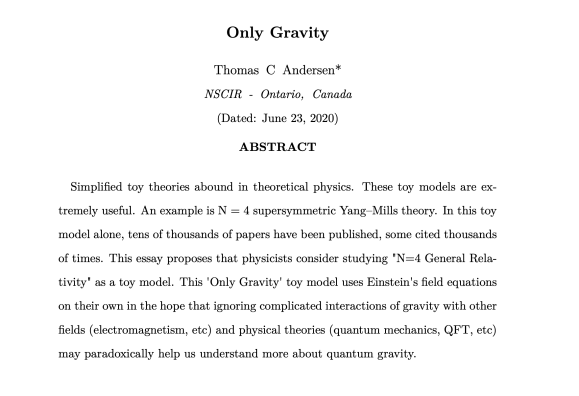Abstract
(This article is a work in progress…)
We posit that the de Broglie wave as a real physical wave produced by interactions between any massive particle and the gravitational background zero point field.
de Broglie waves are tied to momentum. They are associated with any free particle. For instance an electron or a Buckyball. In my view they are some sort of beat phenomenon – doppler effect.
There is a huge background of Gravitational waves at some very large frequency – (perhaps Planckian).
How physically would waves associate with every single mass ? The only possible coupling is through mass itself. So what is the result of something the mass of an electron on a homogenous gravitational wave background?
The mass will distort the background wave pattern.
From this distortion would come some sort of interference pattern. Think of the rubber mat analogy. There would be a dent for the electron in a sea of waves. Would this effect a much much lower frequency effect – de Broglie waves -?
If we take the mass of the particle as m, and the frequency of the background waves as 1.85e43 Hz. Perhaps this gives us the ‘dark energy’, along with quantum guidance rules.
Introduction
The de Broglie wave is a wave that can be used to predict the quantum behaviour of particles. Its a wavelength that is tied to momentum.
The de Broglie wavelength is the wavelength, λ, associated with a massive particle and is related to its momentum, p, through the Planck constant, h:

This wave seems puzzling. Its tied to momentum, so for an observers travelling with different velocities will measure different de Broglie wavelengths. This is often taken as an indication of the non – reality of these waves. But there is a simple explanation for this – and its based on special relativity.
de Broglie beats and the Compton frequency:
"de Broglie made a second, less well known conjecture. If you combine
the E=mc2 and the E=hf equations (where f is frequency), you arrive
at the Compton frequency. de Broglie's conjecture was that the
Compton frequency reflected, in the case of the electron (quarks
were not yet discovered), some kind of fundamental intrinsic
oscillation or circulation of charge associated with the electron.
However it is now known that this presumed oscillation can also be
interpreted instead as being externally driven by the zero-point
fluctuations of the quantum vacuum (see chap. 12 of the monograph
"The Quantum Dice" by de la Pena and Cetto).
Now comes a very intriguing result. One can easily show that if the
electron really does oscillate at the Compton frequency in its own rest
frame, when you view the electron from a moving frame a beat frequency
becomes superimposed on this oscillation due to a Doppler shift. It turns
out that this beat frequency proves to be exactly the de Broglie wavelength of a moving electron." http://www.calphysics.org/mass.html
There is still a problem though. The de Broglie relationship holds for any object, experimentally measured up to a Buckyball with hundreds of component particles. Thus the de Broglie wavelength is some effect of mass combined with motion. The only effect that mass has on a purely classical geometric world is the Schwarzschild ‘indent’ on the background space time.
So how can an indent give rise to a beat frequency?
This result may be generalized to include ZPF radiation from all other directions, as
may be found in the monograph of de la Pena and Cetto [5]. They conclude by stating:
“The foregoing discussion assigns a physical meaning to de Broglie’s wave: it is the mod-ulation of the wave formed by the Lorentz-transformed, Doppler-shifted superposition of the whole set of random stationary electromagnetic waves of frequency ωC with which the electron interacts selectively.”
Assume some white noise like stochastic gravitational wave spectrum as a background on that exists everywhere in the universe (as it undoubtedly does, with only the amplitude unknown). What is the result of viewing a truncated Schwarzschild solution moving (say slowly to ease the math at first) through this background?
One would expect lensing of this stochastic field. The field will refract modes that match its characteristic size. This size scales to its mass. First consider a particle at rest with respect to the observer. With the dent this causes in space time we see a time dilation which affects the waves cumulatively, causing an internal Compton frequency – which is a result of the

Another solution as explained by Rober Schuler
There is an obvious heuristic, however, which provides the needed frequency sum to a good
approximation. We need only assume that, like Schrödinger waves, de Broglie waves are related to the probability of finding a particle. Let p(A) be the probability of finding A, and p(B) the probability of finding B, and assume these meanings continue to hold if A and B are bound together. One of the interesting aspects of de Broglie’s paper (actually his thesis, which was printed in a journal), is a section treating bound particles where both are considered to be moving. [Ibid. 12] By contrast, when using Schrödinger’s analysis, stationary confinement boundaries and potentials are used (which would be associated with particles, e.g. a stationary nucleus, that have infinite de Broglie wavelength). Since we are only able to find the bound pair AB if we find both A and B, then the probability of finding AB must be p(AB) = p(A)p(B). If “p” is a sinusoidal function, then indeed the product of two such functions reduces by a common trig identity to a term involving the sum of the frequencies of p(A) and p(B), and a term involving their difference. The sum frequency corresponds perfectly to the frequency of the sum of the masses of A and B.
The only problem is what to do with the difference frequency? Wignall’s method was speculative, and we can’t use it anyway because he was not using probability, but complex valued functions. However, as an approximation we can observe two things. First, in the case of common nuclear particles, whether we treat them as hadrons (protons, neutrons), or quarks, the masses are approximately the same and the difference frequencies are therefore approximately zero. Second, in the case of the binding of electrons to a nucleus, the electron mass is to a good approximation negligible. It
Once this relationship is obtained, the de Broglie matter waves are a necessary conclusion, as the literature indicates.
So one is left with the task of showing that any truncated Schwarzschild solution will cause an internal frequency – a mode trap – when its sitting in a stochastic gravitational field.
The next step
Assume standing GR waves (in well defined the universal rest frame). 1.85e43 Hz. Then there is a Schwarzschild solution sitting in that standing wave bath.
Time dilation lapse function sqrt(1- 2M/r) becomes simply 1-M/r unless you are within 1e-30m of an electron. So that is the lapse function. What beat frequency does our planckian background generate ? – The compton frequency. Redshift.
https://en.wikipedia.org/wiki/Gravitational_redshift – there are
Take equation for z (r -> inf) and mult by the huge planck frequency. You then get the compton frequency. Solve the equation for the radius of the electron and get the planck length. (But this requires that the electron is quite small and that the buckyball is even smaller! – also this calculation is for a monochromatic wave – not a stochastic background). What about using the width of the
So that is the size of the electron. One planck size will give you a gravitational (blueshift from outside) of the compton electron frequency.
https://en.wikipedia.org/api/re
st_v1/media/math/render/svg/d50a640dc99823e7f650b0c2580ec3bc51ea7ddd
Coulomb Attraction
de Broglie
The proton de Broglie frequency is about the exact same number – 
“He asserted that quantum mechanics was intrinsically relativistic and proposed that the pilot wave originates in internal particle oscillations at the Compton frequency, ωc =mc2/h ̄, at which rest mass energy is exchanged with wave energy. He proposed that the guiding wave field evolves according to the Klein-Gordon equation and consists of a monochromatic wave field in the particle’s frame of reference. The de Broglie relation, p = h ̄ k, then relates the particle momentum to the de Broglie wavelength, λdB = 2π/k. Finally, he stressed the importance of the harmony of phases, by which the particle’s internal vibration, seen as that of a clock, stays in phase with its guiding wave (de Broglie 1930, 1987). Thus, according to his conception, the wave and particle maintain a state of resonance.” [reference]
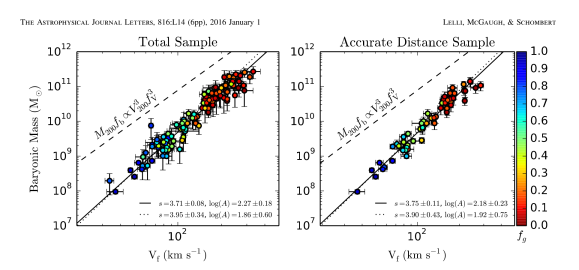







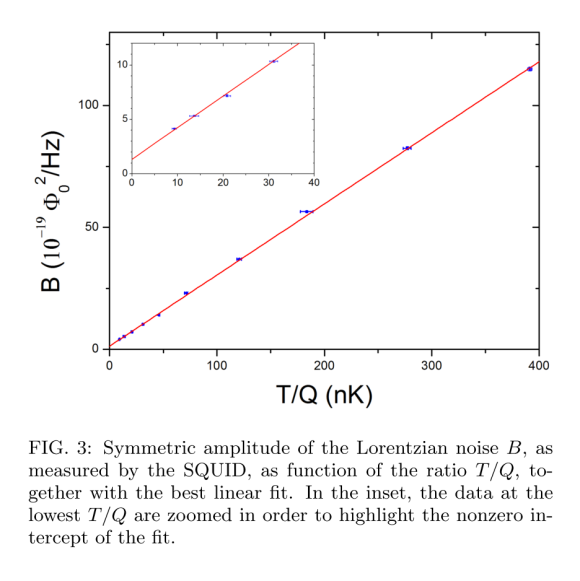 The finite intercept, clearly visible in the inset of Fig. 3 implies that the data are not compatible with a pure thermal noise behavior, and a nonthermal ex-cess noise is present.
The finite intercept, clearly visible in the inset of Fig. 3 implies that the data are not compatible with a pure thermal noise behavior, and a nonthermal ex-cess noise is present.



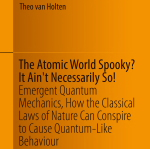







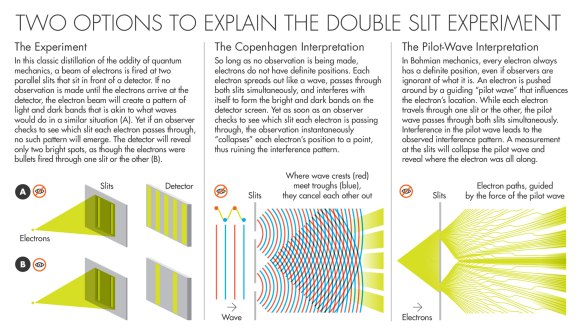

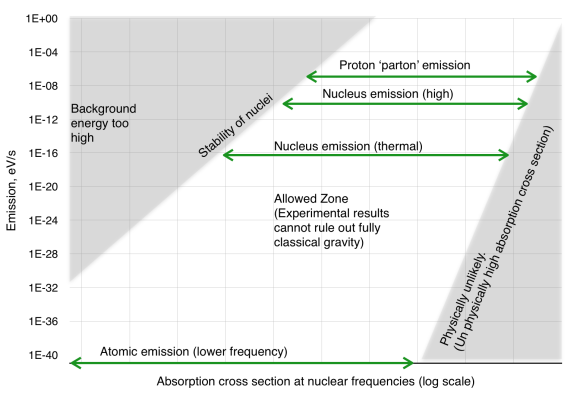
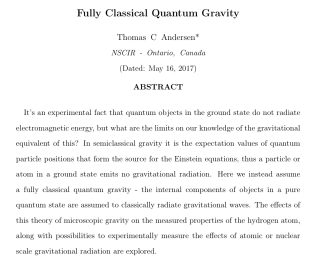





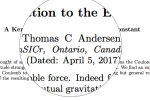

 so h = sqrt(32*pi*G*tGW/(w**2c**2)).
so h = sqrt(32*pi*G*tGW/(w**2c**2)).



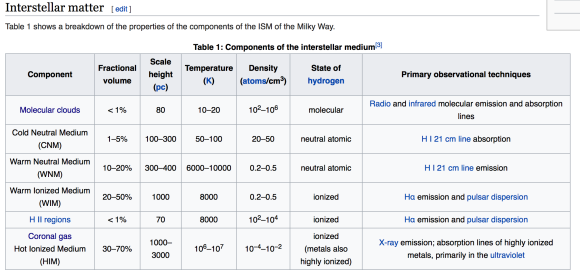




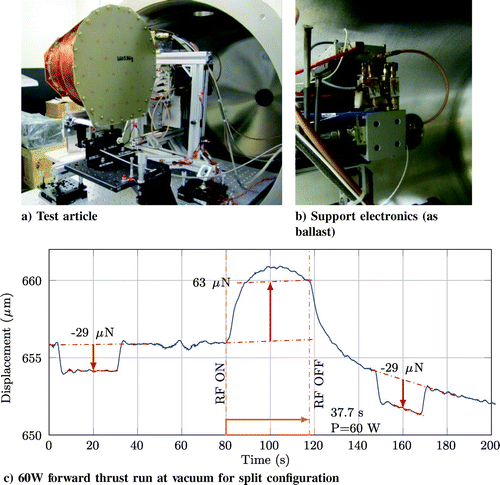




 Andersen, T. C. on ORCID
Andersen, T. C. on ORCID



